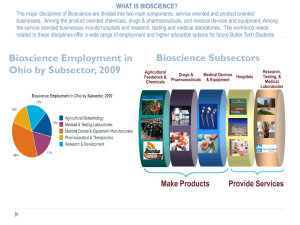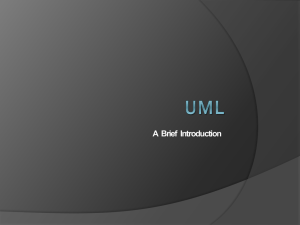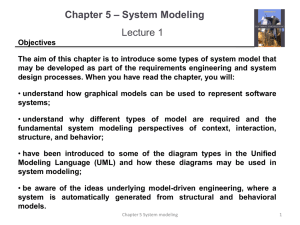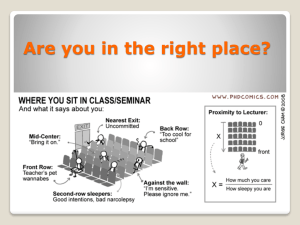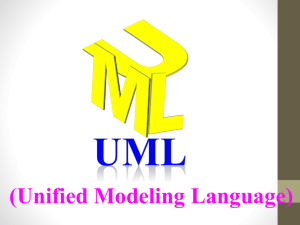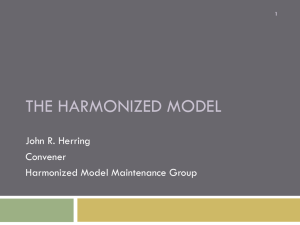Object Oriented Analysis & Design & UML (Unified Modeling
advertisement
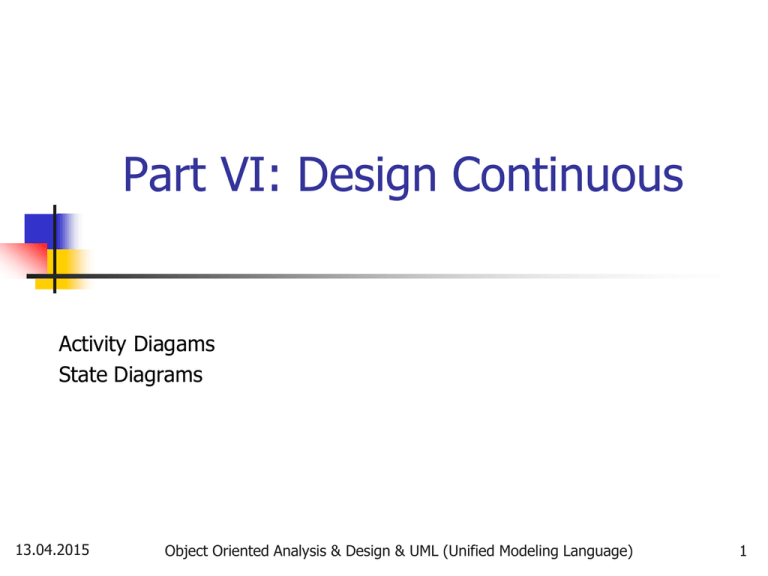
Part VI: Design Continuous Activity Diagams State Diagrams 13.04.2015 Object Oriented Analysis & Design & UML (Unified Modeling Language) 1 Content 13.04.2015 Activity Diagams State Diagrams Object Oriented Analysis & Design & UML (Unified Modeling Language) 2 Activity Diagrams 3 Activity Modeling a specialized type of behavioral modeling a special form of state machine to model not states of objects applied in conjunction with 13.04.2015 the computations and workflow Represents the state of execution concerned with modeling the activities and responsibilities of elements. sequence and collaboration modeling Object Oriented Analysis & Design & UML (Unified Modeling Language) 4 Activity Diagrams widely used in analysis to model but also in design to model 13.04.2015 a use case flow flow between the use cases with no use of classes, objects, etc. details of operation details of algorithm Object Oriented Analysis & Design & UML (Unified Modeling Language) 5 Using Activity Diagrams activity diagram can be Activity diagrams are typically attached to 13.04.2015 attached to any modeling element for the purpose of modeling the behavior of that element. use cases classes interfaces components nodes collaborations operations and methods Object Oriented Analysis & Design & UML (Unified Modeling Language) 6 Action States Operation of Object Oriented systems a society of objects Elements communicate with one another each element has An action state processing as an element fulfills a responsibility Example (the project management system states) 13.04.2015 the responsibility of reacting to the communications it receives. Project Manager Enters Report Criteria Project Management System Generates Report Printer Prints Report Object Oriented Analysis & Design & UML (Unified Modeling Language) 7 Types of action states Initial action state A final action state the last action state is shown using “a bull's eye” An activity diagram 13.04.2015 the first action state may have only one initial action state, but may have any number of final action states. Object Oriented Analysis & Design & UML (Unified Modeling Language) 8 Flow Transitions shows how action states are ordered or sequenced. Whenever an action or subactivity state finishes its work, there is a transition out of the state into the next state types of flow transitions: control-flow object-flow transitions 13.04.2015 Object Oriented Analysis & Design & UML (Unified Modeling Language) 9 Control-Flow Transitions indicates Once a source action state completes its processing, a target action state 13.04.2015 the order of action states starts its processing Object Oriented Analysis & Design & UML (Unified Modeling Language) 10 Example Control Flow Transitions task of generating a report for the project management system order of action states: The Project Manager Enters Report Criteria The Project Management System 13.04.2015 Generates Report The Printer Prints Report Object Oriented Analysis & Design & UML (Unified Modeling Language) 11 Control-flow transitions 13.04.2015 Object Oriented Analysis & Design & UML (Unified Modeling Language) 12 Default transitions Control-flow transitions are also known as default transitions or automatic transitions, because they are unlabeled and are immediately triggered 13.04.2015 after the source action state completes processing. Object Oriented Analysis & Design & UML (Unified Modeling Language) 13 Decisions A decision involves selecting one control-flow transition 13.04.2015 out of many control-flow transitions based upon a condition Object Oriented Analysis & Design & UML (Unified Modeling Language) 14 Swimlanes a visual region in an activity diagram Represents use cases classes components organizational units roles in business modeling in workflow modeling indicates the element has responsibility for action states within the region 13.04.2015 Object Oriented Analysis & Design & UML (Unified Modeling Language) 15 Object-Flow Transitions Indicates an action state input or output an object can modify object state An object-flow transition is shown as a dashed arrow between an action state and an object. Activities may input and output objects and can modify object state show this on an activity diagram as an object flow 13.04.2015 Object Oriented Analysis & Design & UML (Unified Modeling Language) 16 Types of Object-Flow Transitions An action state uses an object as input: show with object-flow transition arrow Point An action state updates or produces an object: Show with the object-flow transition arrow Point 13.04.2015 from the object to the action state. from the action state to the object Object Oriented Analysis & Design & UML (Unified Modeling Language) 17 Control-flow and object-flow transitions Without unnecessary control-flow transitions 13.04.2015 Object Oriented Analysis & Design & UML (Unified Modeling Language) 18 Signals A signal is a way of representing a package of information that is communicated asynchronously A signal event occurs when an object receives a signal When an event is received 13.04.2015 between two objects. by an object it may trigger a state transition in it Object Oriented Analysis & Design & UML (Unified Modeling Language) 19 Sending & Receiving Signals the signal called Order is sent to the :MailOrderCompany external object we wait in the signal receipt for a signal called Goods delivered 13.04.2015 Object Oriented Analysis & Design & UML (Unified Modeling Language) 20 Signals are classifiers Modeled as stereotyped classes. The purpose of a signal is to provide asynchronous communication of information between objects and so, unlike ordinary classes, they only have attributes and the single implicit operation send(targetSet) allows them to be sent to a set of target objects. As this operation is implicit, The signal attributes 13.04.2015 it is never actually shown on signal diagrams it is just assumed that it is there for every signal. specify the information content of the signal Object Oriented Analysis & Design & UML (Unified Modeling Language) 21 Example: GUI events a generalization hierarchy of raw GUI events modeled as signals 13.04.2015 Object Oriented Analysis & Design & UML (Unified Modeling Language) 22 Concurrency 13.04.2015 selecting multiple transitions simultaneously Object Oriented Analysis & Design & UML (Unified Modeling Language) 23 State Diagrams 13.04.2015 Object Oriented Analysis & Design & UML (Unified Modeling Language) 24 State Diagrams also known as depict the lifecycle of elements statechart diagrams state machines (in UML 2.0) that make up a system State modeling is a specialized type of behavioral modeling concerned with modeling 13.04.2015 the lifecycle of an element Object Oriented Analysis & Design & UML (Unified Modeling Language) 25 States: Definition A state is a condition of being at a certain time. is drawn as a rounded rectangle with the name of the state in the center can be a passive quality, an active quality (object is doing something 13.04.2015 Example: light object=> On and Off. Example: Person => moving, sleeping, reading, … Example: coffeemaker => Brewing Object Oriented Analysis & Design & UML (Unified Modeling Language) 26 Simple States indicates a condition or situation of an element. Example: the project management system Inactive is not available to its users, because it is not started or has been shut down Active started and available to its users Suspended has encountered some severe error, Possible reason: 13.04.2015 is running low on secondary storage requires user intervention Object Oriented Analysis & Design & UML (Unified Modeling Language) 27 Initial and Final States Initial state the state of an element , when it is created. is shown with a small solid filled circle. A final state the state of an element is shown with 13.04.2015 when it is destroyed. a circle surrounding a small solid filled circle a bull's eye Object Oriented Analysis & Design & UML (Unified Modeling Language) 28 Transitions A transition, shown with an arrow represents a change of states from a source state to a target state A transition description, written along the arrow, describes the circumstances 13.04.2015 causing the state change to occur. Object Oriented Analysis & Design & UML (Unified Modeling Language) 29 Trigger A trigger is an event cause a transition. Example: User input processing systems a keystroke trigger may cause the system to change states 13.04.2015 from Gathering input to Processing input. Object Oriented Analysis & Design & UML (Unified Modeling Language) 30 Transition Variations A trigger with no guard the transition is taken This is useful for modeling a state change in response to an event. A trigger with a guard the transition is taken when the trigger occurs if the guard evaluates to true. Otherwise, the transition isn't taken. Combining a trigger and a guard is useful when the trigger occurs. for modeling a transition is blocked depending on a condition. Neither a trigger nor a guard are specified, the transition is taken immediately after the source state's internal behavior 13.04.2015 Object Oriented Analysis & Design & UML (Unified Modeling Language) 31 The life cycle of an object the life cycle of an AccountApplication object 13.04.2015 as it passes from pending to approved or rejected and then to finalizing Object Oriented Analysis & Design & UML (Unified Modeling Language) 32 Example how to use State diagram modeling a troll in a FPS game 13.04.2015 FPS: first-person shooter the troll's behavior is determined by his state Object Oriented Analysis & Design & UML (Unified Modeling Language) 33 Composite States A composite state is a state contains one or more state diagrams. Each diagram belongs to a region, A state in a region is referred to as a substate of the composite state. Composite states work as follows: when the composite state becomes active, the initial pseudostate of each region becomes active, and the contained state diagrams begin executing. if a trigger on the composite state occurs 13.04.2015 regions are divided by a dotted line The contained state diagrams are interrupted Object Oriented Analysis & Design & UML (Unified Modeling Language) 34 Composite States Example Composite states contain 13.04.2015 one or more state diagrams; execute in parallel Object Oriented Analysis & Design & UML (Unified Modeling Language) 35 Advanced Pseudostates A choice pseudostate determines which transition is followed. has guards 13.04.2015 used to emphasize a Boolean condition represented on outgoing transitions the transition depends on the guard. Object Oriented Analysis & Design & UML (Unified Modeling Language) 36 Fork and join pseudostates show branching 13.04.2015 into concurrent states and then rejoining Object Oriented Analysis & Design & UML (Unified Modeling Language) 37 Signals transition-oriented view: to draw attention 13.04.2015 to transitions and transition behavior using special icons for transitions. Object Oriented Analysis & Design & UML (Unified Modeling Language) 38 End of Chapter 13.04.2015 Object Oriented Analysis & Design & UML (Unified Modeling Language) 39

